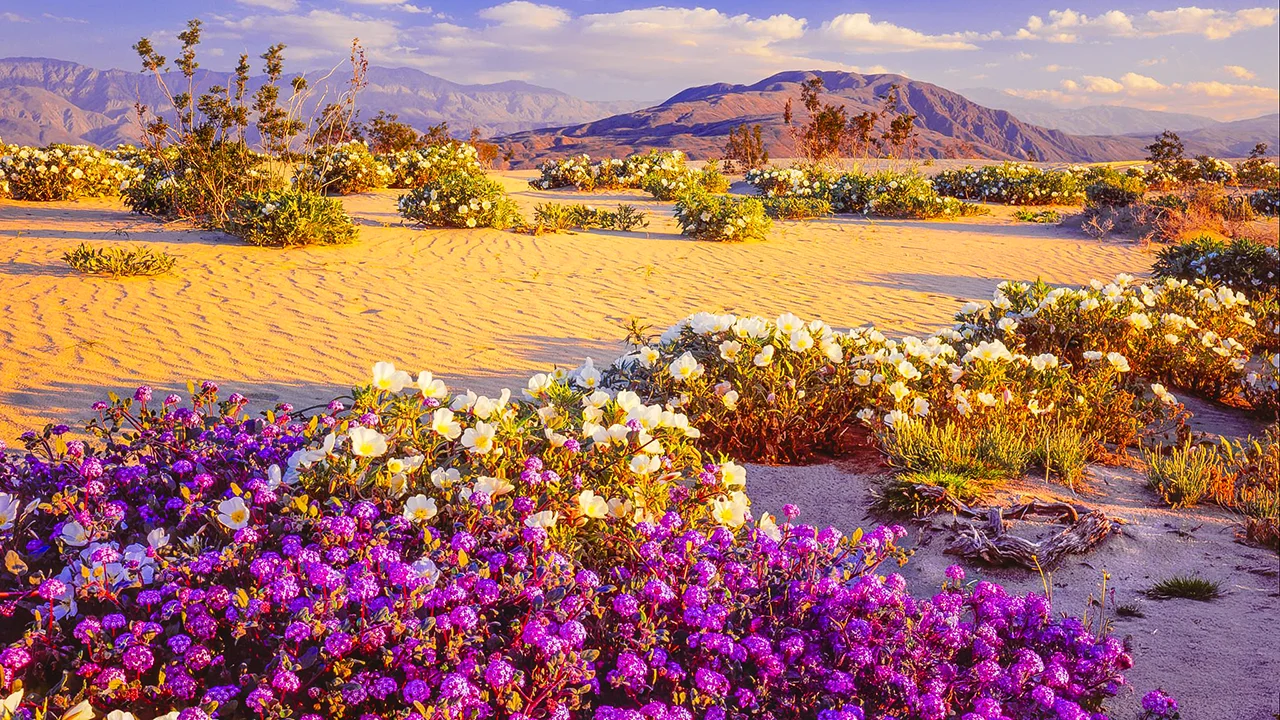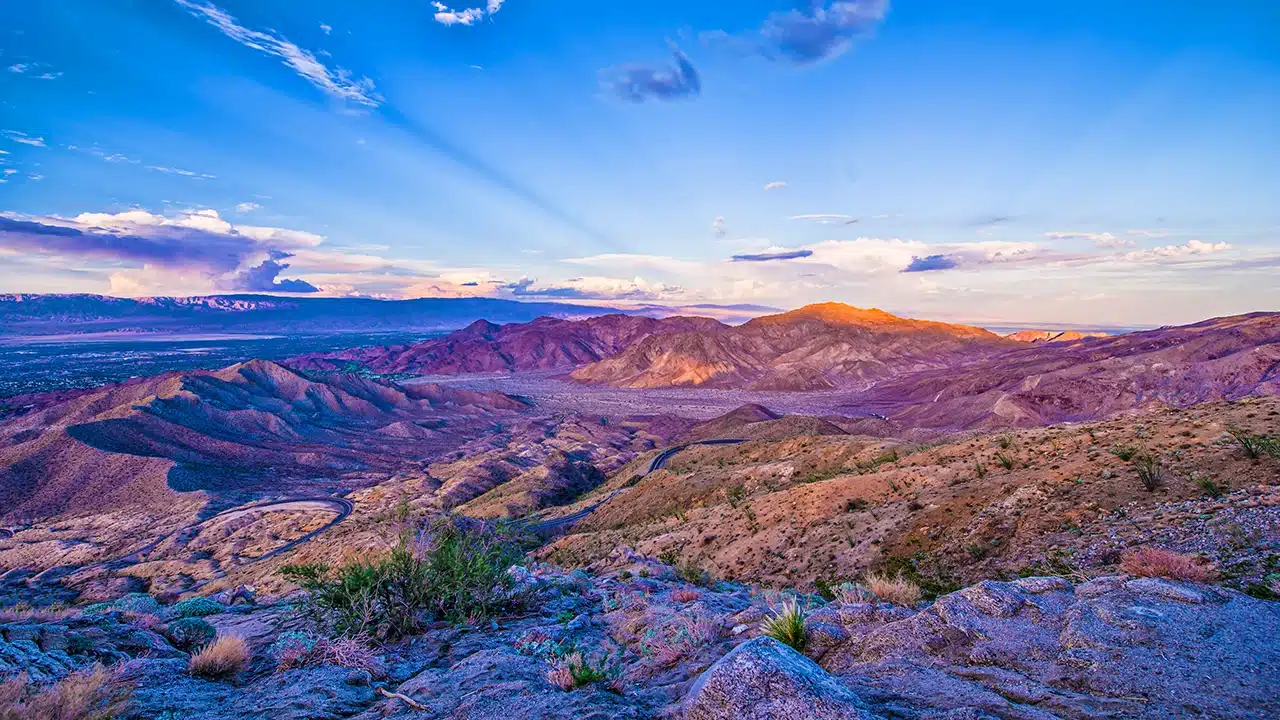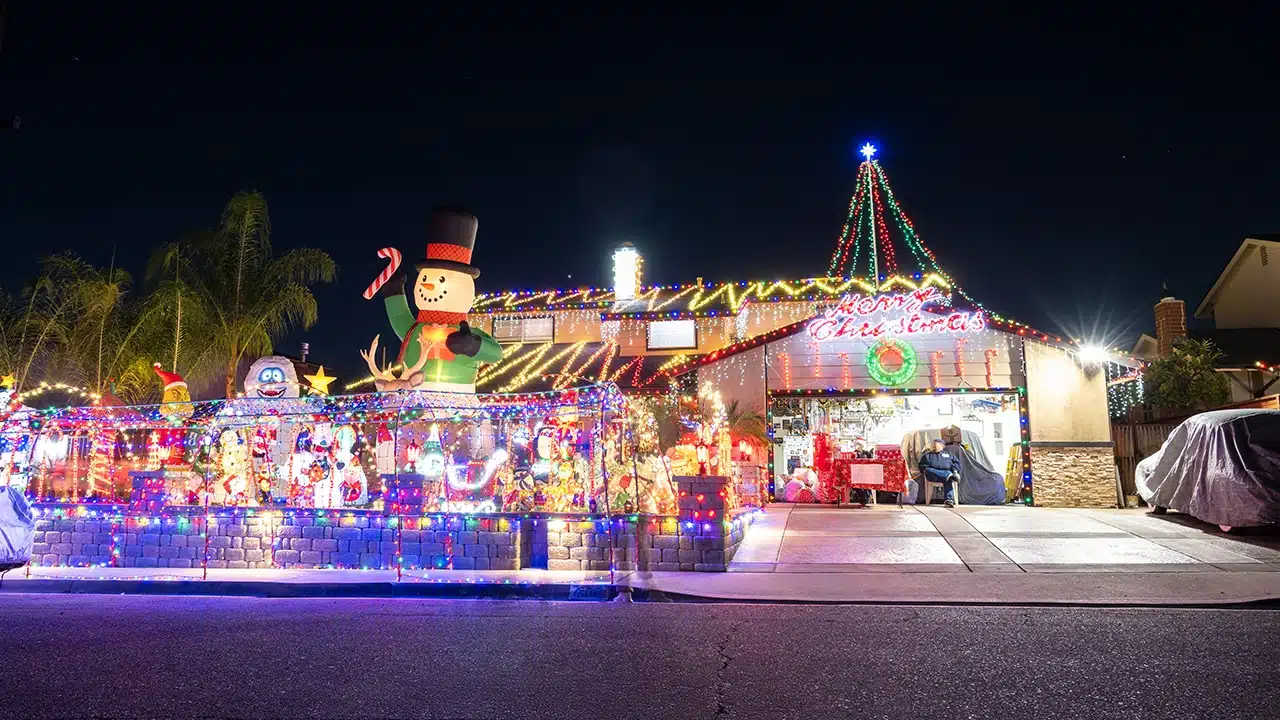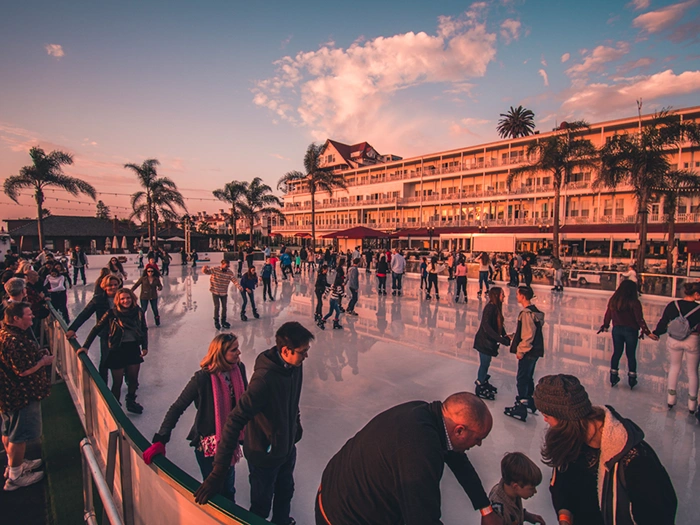Last spring, our campground neighbor at Desert Hot Springs knocked on our Winnebago door at sunrise, practically bouncing with excitement. “You’ve got to see this!” she said, pointing toward what looked like empty desert. That moment changed everything we thought we knew about Palm Springs.
While most visitors focus on resort pools and golf courses, they’re missing nature’s most incredible annual show. When conditions align perfectly between late February and mid-April, the entire Coachella Valley transforms into a breathtaking wonderland of color. We’re talking brilliant orange California poppies, purple lupines, and yellow desert marigolds stretching to the horizon—colors so vibrant they put any resort landscaping to shame.
Here’s what we learned the hard way after missing spectacular blooms on our first two trips: timing is absolutely everything. There’s a narrow window when Mother Nature puts on her show, and if you miss it, you’ll see the brown terrain everyone expects from the desert.
Quick Planning Guide
- Best Viewing Season: Late February through mid-April (peak typically mid-March)
- Ideal Conditions: 4-6 weeks after significant winter rainfall
- Best Times: Early morning (6-10 AM) or late afternoon (4-6 PM)
- What to Bring: 2+ liters of water per person, sunscreen, sturdy hiking shoes, camera
- RV-Friendly Access: Most locations have adequate parking; some require short walks from parking areas
Where to Find the Best Wildflower Displays
Easy Access Locations
Murray Canyon Trail offers spectacular displays just 15 minutes from downtown Palm Springs. This 3-mile round-trip hike features desert dandelions, lupine, and evening primrose carpeting the canyon floor. The trailhead has RV-friendly parking, and the mostly flat terrain works well for families.
Mission Creek Preserve provides a gentler introduction to desert blooms with its 1.5-mile loop trail. Here you’ll find some of the most accessible photography spots, especially where Ghost Flower and Desert Five Spot create natural color combinations.
Moderate Adventures
South Carl Lykken Trail rewards hikers with elevated views of valley-wide blooms. The 2.5-mile trail gains 300 feet of elevation, offering panoramic vistas perfect for capturing the scale of desert wildflower displays.
Randall Henderson Loop Trail in Indian Canyons combines cultural history with natural beauty. This 3-mile loop showcases how indigenous peoples used desert plants, while spring blooms add vibrant color to ancient palm groves.
Extended Exploration
Anza-Borrego State Park (90 minutes from Palm Springs) hosts California’s most famous wildflower displays across 600,000 acres. During exceptional years, entire hillsides disappear under blankets of Desert Sunflowers and Fairy Dusters. The park offers a range of experiences, from roadside viewing to challenging backcountry hikes. Be sure to visit the park’s website here for more information.

Desert Wildflowers You’ll Encounter
The diversity of desert wildflowers around Palm Springs surprises first-time visitors. Each species has adapted unique strategies for desert survival, creating fascinating variety in color, size, and blooming patterns.
California Poppies steal the show with their brilliant orange petals that seem to glow in desert sunlight. These hardy flowers can cover entire hillsides during peak years, creating Instagram-worthy landscapes.
Desert Dandelions showcase bright yellow blooms growing up to 14 inches tall, particularly abundant in Palm Canyon’s sandy washes.
Bladderpod creates dramatic vertical accents at Coachella Valley Preserve, with some plants towering over six feet tall and producing clusters of yellow flowers.
The Brown-eyed Primrose thrives in sandy terrain throughout the valley, featuring distinctive grayish-green leaves with dark-centered, white blooms that open in the evening.
Ghost Flower (Desert Lupine) produces purple flower spikes that contrast beautifully against red rock formations, especially photogenic during golden hour lighting.
Chuparosa features vibrant, tubular red flowers that attract hummingbirds, creating opportunities for wildlife photography alongside its floral displays.
Beyond the Blooms: Year-Round Desert Wonders
Even outside wildflower season, the California desert offers permanent geological masterpieces worth the journey.
Giant Rock in nearby Landers stands seven stories tall and weighs 30,000 tons, making it the world’s largest freestanding boulder—a fascinating stop for geology enthusiasts.
Cholla Cactus Garden in Joshua Tree National Park spans 10 acres of teddy bear cholla, creating an otherworldly landscape that’s particularly stunning during sunrise and sunset.
Painted Canyon in the Mecca Hills reveals colorful rock formations carved by the San Andreas Fault. The 4.5-mile sandy loop trail winds through narrow slot canyons that showcase millions of years of geological history.
Tahquitz Canyon surprises visitors with its 60-foot waterfall—a hidden oasis that challenges every assumption about desert landscapes.
Maximizing Your Wildflower Experience
Timing Your Visit
Check recent rainfall patterns before planning your trip. Desert wildflowers need specific conditions: adequate winter precipitation followed by warm spring temperatures. Local ranger stations and visitor centers provide current bloom reports, or check online resources like the Desert Wildflower Hotline.
Early morning visits offer the best lighting for photography and cooler temperatures. Many flowers close during midday heat, so plan accordingly. Late afternoon provides beautiful golden hour lighting but can be quite warm.
Photography Tips
Wildflower photography in the desert requires different techniques than typical landscape shooting. Get low to capture flowers against interesting backgrounds like rock formations or distant mountains. Use a polarizing filter to reduce glare and enhance color saturation.
Macro lenses reveal intricate details of individual blooms, while wide-angle shots capture the scope of mass displays. Don’t forget to include some landscape context—the contrast between delicate flowers and harsh desert terrain tells the complete story.
Responsible Exploration
These fragile desert ecosystems depend on respectful visitors. Stay on designated trails to protect delicate root systems and soil crusts that take decades to develop. Many desert animals depend on wildflower seeds and nectar for survival, so resist the urge to pick flowers.
Pack out all trash and avoid creating new trails or shortcuts. The Leave No Trace principles are especially crucial in desert environments where recovery from damage takes much longer than in other ecosystems.
Consider joining guided tours led by local naturalists. These experts can identify species you might miss and share fascinating details about desert adaptations and ecology. Many tours also support local conservation efforts.
Planning Your Desert Bloom Adventure
The key to successful wildflower viewing lies in flexibility and preparation. Weather patterns vary significantly year to year, so monitor bloom reports starting in late February. Some years produce spectacular displays, while others offer more modest shows.
Book accommodations early during peak season, as wildflower enthusiasts fill area campgrounds and hotels quickly once bloom reports turn positive. Emerald Desert RV Resort is located in the heart of the desert and offers the best rates during the spring months. Visit our website here for more information.
Don’t limit yourself to a single day of exploration. Different elevations and microclimates mean bloom timing varies across the region. What’s past peak in the valley floor might just be starting in higher elevations or north-facing slopes.
The California desert’s wildflower displays represent one of nature’s most remarkable transformations. When those perfect conditions align—adequate winter rain, warm spring days, and minimal wind—the result is pure magic. It’s an experience that transforms how you see desert landscapes forever, revealing the incredible life force thriving in what many consider barren land.
Pack your camera, lace up those hiking boots, and prepare for an adventure that redefines everything you thought you knew about the desert. The California desert bloom awaits, and it’s absolutely spectacular.


